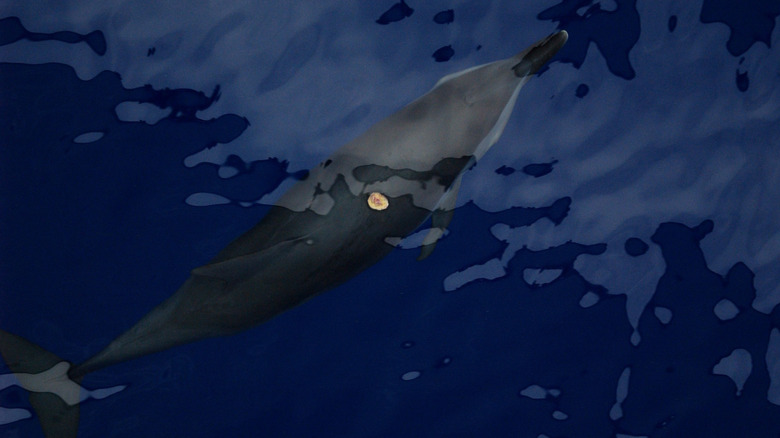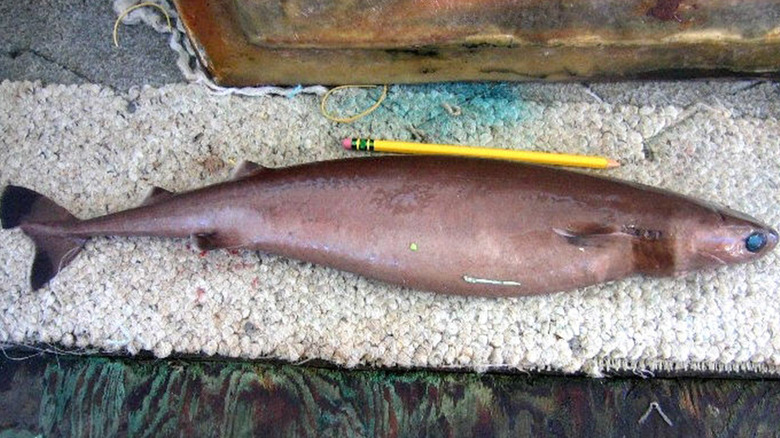The Cookiecutter Shark Might Have A Cute Name, But The Reason For It Is Terrifying
Our collective fear of sharks is so great there's a word for it: galeophobia. A combination of the Greek words for shark, "galeos," and fear, "phobos," the condition can induce feelings of anxiety, shortness of breath, shaking, sweating, nausea, dizziness, and an elevated heart rate. Such a thing is fairly widespread, too. According to a 2015 study, 51% of Americans are terrified of sharks, and 38% admit to being scared to swim in the ocean due to the possibility of a shark attack.
Of course, small zebra or leopard sharks aren't causing galeophobes to sweat and pass out. When we talk about being scared of sharks, we're generally talking about being terrified of great whites rising from the deep to attack "Jaws"-style. But there is another species of shark which, while nowhere near as big as a great white, is just as ominous in its own way.
The cookiecutter shark is actually a very small species that lives in the deep ocean below 3,200 feet. At night, however, the sharks rise to the surface in order to feed, and it's the way they feed which makes them so terrifying.
The small but scary shark that lives in the deep ocean
The cookiecutter shark is a rarely seen species that lives in the mesopelagic zone of the ocean, which extends from 660 feet to 3,300 feet below the surface and which receives very low levels of sunlight (although they have been seen as far as 11,000 feet deep). Sometimes referred to as the twilight zone, the mesopelagic zone is home to several animal species including swordfish, wolf eels, and the lanternfish, which uses phosphorous cells to produce itsown light. Some apex predators will often dive down from the epipelagic zone above to feast on the creatures in the mesopelagic. But cookiecutter sharks are just one example of a species that swims up to dine on animals higher in the ocean.
These elusive fish don't grow bigger than 18–20 inches long, and have a cigar-shaped body, hence the other name by which they're known: cigar shark. Small fins sit towards the back end of their body while small light-producing organs called photophores produce a green glow on their underside. This strange deep-sea morphology already gives the cookiecutter shark a certain eerie aura, but its feeding habits are what truly make this a shark almost as scary as a great white.
You might expect these small creatures to stay away from larger fish. But the cookiecutter shark is as bold as it is small, and has no problem getting close enough to larger animals in order to feed.
The cookiecutter shark is actually a parasite
The cookiecutter shark is actually considered a parasite due to the way in which it feeds on larger fish and marine mammals without killing them. These small sharks typically swim towards the surface at night to feed on larger prey, which is then attracted to the cookiecutter sharks' glowing light. The sharks then use their sucking lips and sharp upper teeth to latch onto their prey before using a lower row of thick serrated teeth to bite out circular chunks of flesh, twisting in the water to remove the flesh from their victim, before receding to the depths once again. This practice leaves distinctive circular wounds on victims, as if a perfect circle of flesh has been removed.
Despite the small size of cookiecutter sharks, they have an impressive array of teeth and the largest teeth-to-body ratio of any shark. Each shark has 30 to 37 small teeth in their upper jaw, while the bottom jaw features 25 to 31 larger triangular teeth. The larger the shark, the more teeth they're likely to have. Interestingly enough, a cookiecutter shark's bottom teeth are not individual, rather they're interconnected at the bases, essentially making them one long rack. This means that when cookiecutter sharks lose their teeth, they lose the entire row, which they swallow in its entirety, making them very unusual among sharks in that respect. Scientists believe that swallowing their teeth allows the sharks to recycle the calcium to aid in future tooth generation. Cookiecutter sharks lose and grow new sets of teeth multiple times throughout their lives, allowing them to maintain sharp teeth capable of biting into larger prey with ease.
Cookiecutter sharks aren't a major threat to humans
While the idea of a small shark coming up from the deep to take a bite of flesh out of your body before disappearing might sound scary, there's no need to be too scared of cookiecutter sharks. The small fish typically feed on other sea creatures including marlin, tuna, and stingrays, but scars have also been found on great white sharks and spinner dolphins. That being said, there have been some instances where cookiecutter sharks have attacked humans.
The first documented attack by a cookiecutter shark on a human was in 2009 when one of the creatures took a bite out of a distance swimmer's leg as he swam from the island of Hawai'i to Maui. According to the International Shark Attack File (ISAF), there have since been several more attacks, with three unprovoked examples occurring in 2019 alone. Again, all these attacks were experienced by long-distance swimmers in Hawaii and the only other account of an unprovoked cookiecutter bite on a human happened in Australia in 2017. That's a very small number, especially considering there are more than 6,400 records in the file.
The cookiecutter shark is just one example of a species of fish with terrifyingly sharp teeth. Still, if you happen to be a galeophobe, the last thing you need is to worry about a parasitic shark coming to take a chunk out of your leg while you swim.



